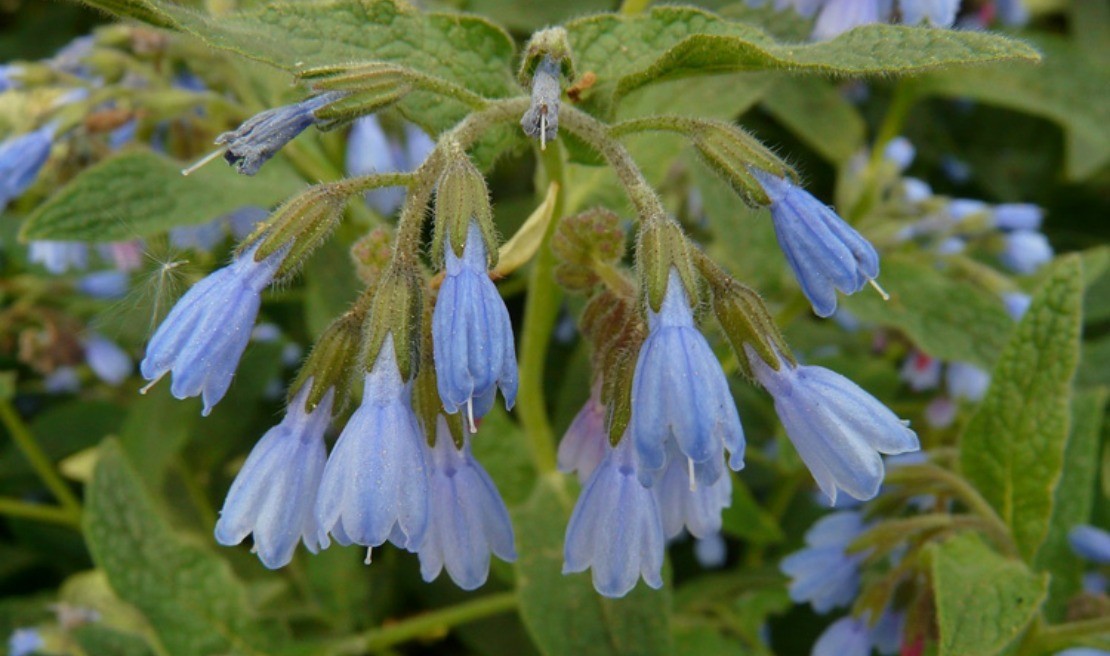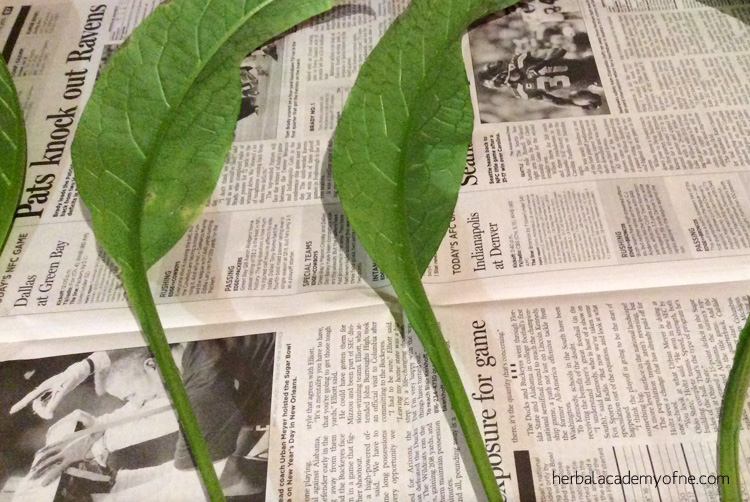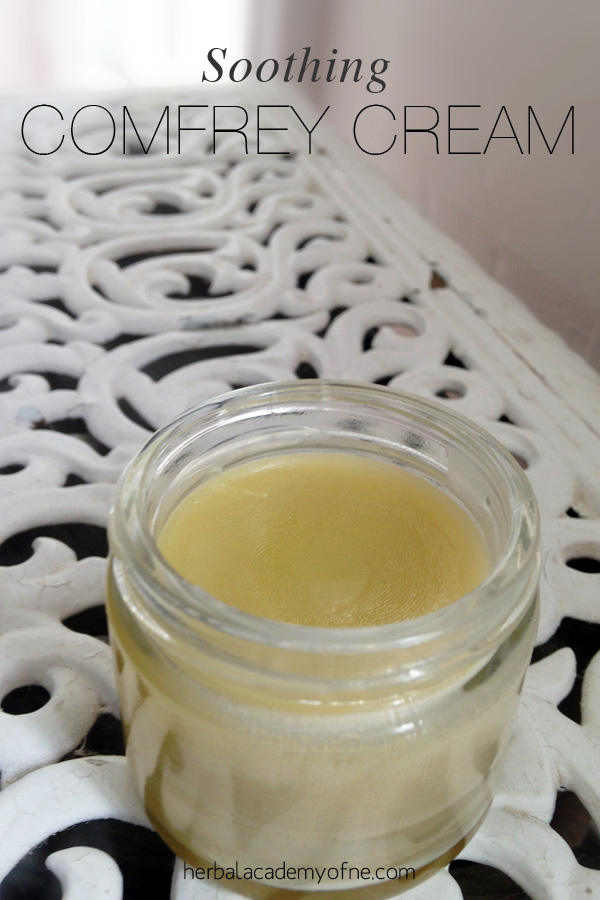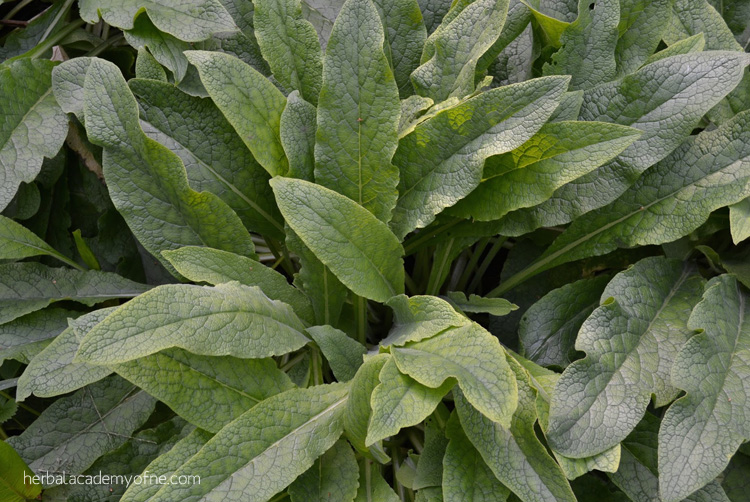
Comfrey Uses + Soothing Comfrey Cream Recipe
I started growing comfrey a couple of years ago, but my reasons were NOT strictly altruistic. Don’t get me wrong, I love all of my herbs, but I particularly love perennial herbs like comfrey that are well suited to a pot and can be brought indoors during our cold Kansas winter.
There is Comfort in Comfrey
Comfrey (Symphytum officianale), a member of the borage family, is a fast-growing, leafy perennial. The Latin name is from the Greek symphis, which means “growing together of bones” or “knit together.” Comfrey has appeared in the Materia Medica since the Middle Ages and some references to the plant date back as far as 50 AD. True to its Latin name, comfrey was applied externally as a poultice for bruises, sprains and fractures. It was taken internally for a variety of medical aliments ranging from broken bones and gastric ulcers to the treatment of female disorders.
Comfrey contains allantoin, a substance commonly used in the cosmetic industry. Allantoin promotes granulation and cell formation which aids in healing at the cellular level. It has both anti-inflamatory and keratinolytic effects and is useful in the treatment of skin conditions following post radiation in cancer patients. It is now formulated synthetically. Comfrey also contains pyrrolizidine alkaloids (PAs), a known hepatotoxic agent. Overuse of substances containing PAs can lead to severe liver damage and for that reason Australia placed Comfrey on the Poison Advisory List in 1984. Germany and Canada followed suit and in 2001, the FDA asked major manufacturers to remove comfrey from their standard list of ingredients.
(Note from Editor: It should be noted that the studies that led to this decision involved isolating PAs and injecting them at high concentrations into rats. Since a chemical in isolation behaves differently than when present in a whole plant, rats are different than humans, and it is unclear whether common comfrey (S. officinale) or Russian comfrey (S. uplandicum) was used, there is dissension among herbalists regarding this decision and whether comfrey is indeed toxic. We err on the side of caution and recommend avoiding comfrey for internal use particularly in the case of preexisting liver conditions, and if considering internal use we recommend researching this matter for yourself so you have all the facts.)
Growing Comfrey in the Garden
Comfrey is also useful in organic gardening due to its rich nitrogen content. When mulched, the fast-growing leaves make a great compost activator. The leaves are so fast-growing that I can harvest comfrey leaves and within a week they have already grown back by half to their pre-cut size. Needless to say, I am definitely comfortable with comfrey.
Comfrey Uses in First Aid
Remember when I said that my reasons for growing comfrey were not altruistic? Well, it turns out that I am a bit of a rebel at heart. I’ve done extensive reading on comfrey and concluded that when used externally, comfrey is a useful and beneficial herb. As it turns out, I was correct.
Last summer, my husband and I were moving one of my failure-to-thrive beehives. We’d had a delayed and wet spring, and one of my more aggressive hives appeared sickly. I decided to isolate them on a friend’s property away from my healthy hives. After a month of quarantine and a good dose of sunshine, they bounced back and were ready to return to the bee yard. Moving is very stressful to bees. We usually try and move them as near to or after sunset in order to give all the foragers a chance to return to the hive. A rumble or two of thunder is usually enough to send them scurrying back home. I knew the forecast of an impending storm would further aggravate the aggressive nature of this particular hive. I pulled on my Bug Baffler, a protective mesh shirt and a long gloves, but I confess, in my hurry to beat the storm, I opted to forgo my protective pants.
As a beekeeper, stings are to be expected, especially in times of high stress. I got stung on the tender flesh of my inner thigh, not just once, but twice. Normally, I get a localized reaction from a sting, swelling and then itching for 2-3 days. But sensitive areas like the face or inner thigh can be painful and I expected a fair amount of swelling and itching.
I quickly took stock of my herbs and remembered the comfrey leaves I was in the process of drying. Recalling comfrey’s anti-inflammatory effects when applied externally, I decided to make a quick poultice from the steeped comfrey leaves.

Making a Comfrey Poultice
Comfrey leaves should be harvested right before the flower blooms and be used dried or fresh. Steep fresh chopped leaves in water that has been brought to a boil for 20-30 minutes. Strain with a kitchen strainer. I prefer to use a French Press for my herbal teas or tisanes.
Wrap the steeped leaves in cheesecloth, muslin or felt to make a poultice and apply externally. Do NOT apply to broken skin or open wounds. Reapply every 10-15 minutes over the next hour, as needed. Much to my surprise, I had instant relief from the comfrey poultice (more on poultices here)! I then soaked a cotton ball with comfrey and taped it on the sting overnight, and the swelling was gone the next morning.
The tea can be stored in the refrigerator for up to 6 months for cool, soothing use. Do not take internally. Use comfrey for no more than 10 days in a row. Do not use comfrey in the presence of active liver disease or in conjunction with medications that impair liver function.

Soothing Comfrey Cream
Comfrey can also be made into a lovely soothing cream. My husband uses comfrey cream for skeletal muscle pain with great results. And of course, I keep my comfrey cream handy for the pesky bee stings. The following is a recipe for Soothing Comfrey Cream that I make here at home.
Soothing Comfrey Cream
2 cups organic olive oil
1/2 cup beeswax pastilles
1 ounce organic emulsifying wax (or another ounce of beeswax)
2 ounces shea butter or lanolin (your choice)
2-1000 mg vitamin E capsules
5-6 drops essential oil of choice
- Loosely pack a 1 quart mason jar with comfrey leaves. Fill with the olive oil, or enough to cover the comfrey leaves, and allow to infuse for at least 30 days.
- Strain comfrey leaves, yielding approximately 1 1/2 cups of infused oil.
- Place the 1 1/2 cup of infused oil in the top of a double boiler which has been brought to a boil. Turn down heat to a low simmer.
- Slowly add beeswax pastilles and emulsifying wax. I use an organic beeswax/emulsifying wax combination of about 2/3 cup.
- Blend in shea butter or lanolin until melted. Lanolin will produce a slightly greasier formula which can be easier to apply.
- Puncture vitamin E capsules and add oil to the mixture. Vitamin E is soothing to skin and is a natural antioxidant that prevents oxidation and rancidity.
- Add 5-6 drops of essential oil depending on the use. Your choice, but my favorites are lavender to soothe tension and/or lemongrass to aid in healing ligament and muscle tears. Wintergreen is useful for sore muscles and chamomille aids in the reduction of swelling and bruising. You can add a combination that works for you or 2-3 drops to each individual container.
- Pour the melted mixture into containers with lids. Allow to solidify and cool before capping with lids. Label and date.
Using herbs is a personal choice. The use of medicinal herbs has been well documented as an alternative treatment for disease and acute injuries across the world. In many cultures, herbs are used to promote health and restore the human body to a state of balance in order to facilitate the healing process.
Learn more about the internal use of comfrey in our post The Comfrey Controversy: Can and Should One Use Comfrey Internally?

To learn more about the medicinal uses of herbs, consider enrolling in the Introductory Herbalism Course or the Intermediate Herbalism Course. Or check out The Herbarium for extensive plant monographs and articles on herbalism, and learn how to integrate herbal medicine into your daily life.
Bee the Change!
Rebecca O’Bea is a beekeeper and avid gardener from Kansas. A budding herbalist and student at HANE, she can be found most days knee-deep in compost and blogging about her daily life at The Bee Queen. Some photos provided by Rebecca O’Bea, used with permission for this article.








